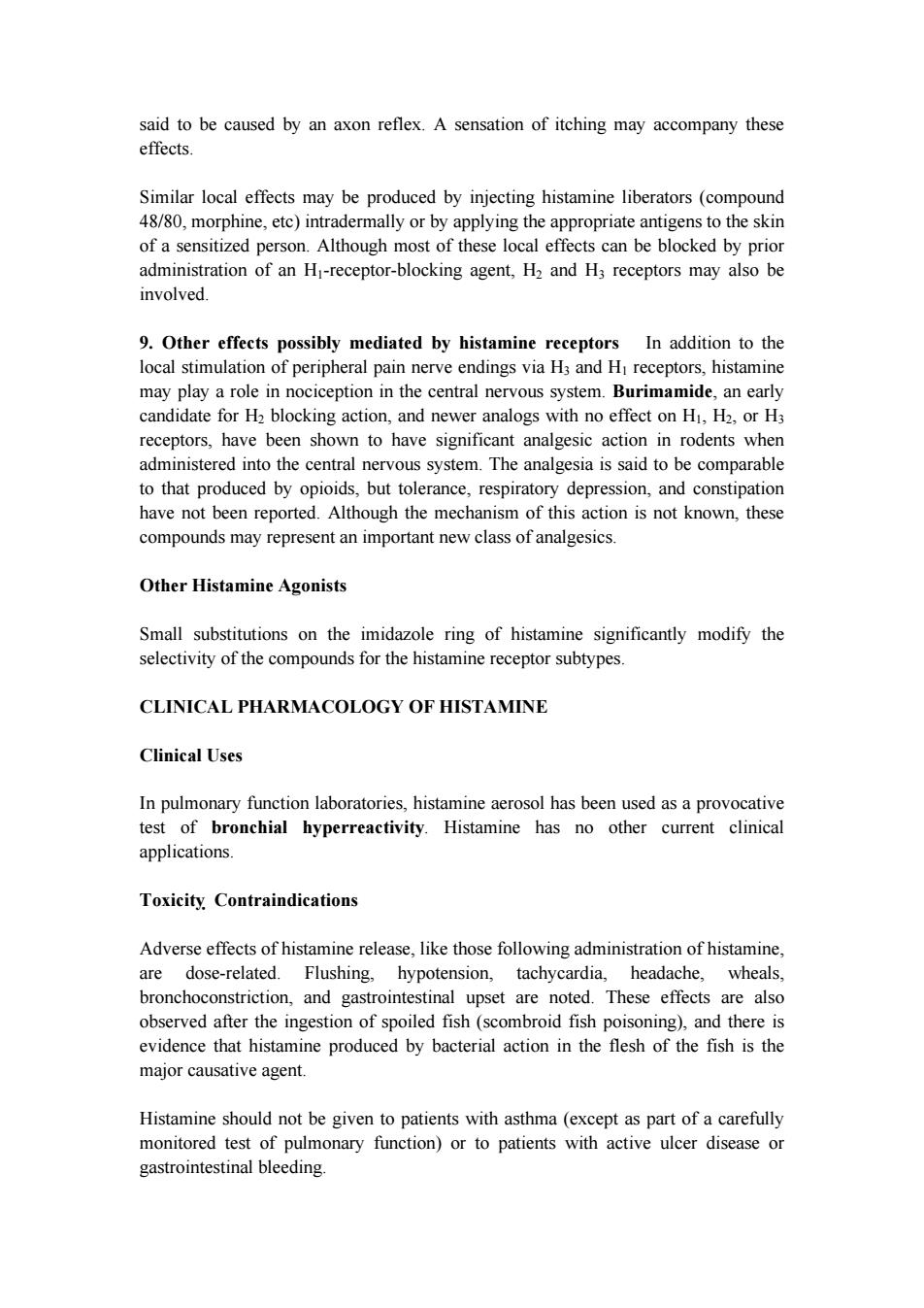正在加载图片...

said to be caused by an axon reflex.A sensation of itching may accompany these effects. Similar local effects may be produced by injecting histamine liberators(compound 48/80,morphine,etc)intradermally or by applying the appropriate antigens to the skin of a sensitized person.Although most of these local effects can be blocked by prior administration of an Hi-receptor-blocking agent,H2 and H3 receptors may also be involved. 9.Other effects possibly mediated by histamine receptors In addition to the local stimulation of peripheral pain nerve endings via H3 and HI receptors,histamine may play a role in nociception in the central nervous system.Burimamide,an early candidate for H2 blocking action,and newer analogs with no effect on Hi,H2,or H3 receptors,have been shown to have significant analgesic action in rodents when administered into the central nervous system.The analgesia is said to be comparable to that produced by opioids,but tolerance,respiratory depression,and constipation have not been reported.Although the mechanism of this action is not known,these compounds may represent an important new class of analgesics. Other Histamine Agonists Small substitutions on the imidazole ring of histamine significantly modify the selectivity of the compounds for the histamine receptor subtypes. CLINICAL PHARMACOLOGY OF HISTAMINE Clinical Uses In pulmonary function laboratories,histamine aerosol has been used as a provocative test of bronchial hyperreactivity.Histamine has no other current clinical applications. Toxicity Contraindications Adverse effects of histamine release,like those following administration of histamine, are dose-related.Flushing,hypotension,tachycardia,headache,wheals, bronchoconstriction,and gastrointestinal upset are noted.These effects are also observed after the ingestion of spoiled fish(scombroid fish poisoning),and there is evidence that histamine produced by bacterial action in the flesh of the fish is the major causative agent. Histamine should not be given to patients with asthma(except as part of a carefully monitored test of pulmonary function)or to patients with active ulcer disease or gastrointestinal bleeding.said to be caused by an axon reflex. A sensation of itching may accompany these effects. Similar local effects may be produced by injecting histamine liberators (compound 48/80, morphine, etc) intradermally or by applying the appropriate antigens to the skin of a sensitized person. Although most of these local effects can be blocked by prior administration of an H1-receptor-blocking agent, H2 and H3 receptors may also be involved. 9. Other effects possibly mediated by histamine receptors In addition to the local stimulation of peripheral pain nerve endings via H3 and H1 receptors, histamine may play a role in nociception in the central nervous system. Burimamide, an early candidate for H2 blocking action, and newer analogs with no effect on H1, H2, or H3 receptors, have been shown to have significant analgesic action in rodents when administered into the central nervous system. The analgesia is said to be comparable to that produced by opioids, but tolerance, respiratory depression, and constipation have not been reported. Although the mechanism of this action is not known, these compounds may represent an important new class of analgesics. Other Histamine Agonists Small substitutions on the imidazole ring of histamine significantly modify the selectivity of the compounds for the histamine receptor subtypes. CLINICAL PHARMACOLOGY OF HISTAMINE Clinical Uses In pulmonary function laboratories, histamine aerosol has been used as a provocative test of bronchial hyperreactivity. Histamine has no other current clinical applications. Toxicity Contraindications Adverse effects of histamine release, like those following administration of histamine, are dose-related. Flushing, hypotension, tachycardia, headache, wheals, bronchoconstriction, and gastrointestinal upset are noted. These effects are also observed after the ingestion of spoiled fish (scombroid fish poisoning), and there is evidence that histamine produced by bacterial action in the flesh of the fish is the major causative agent. Histamine should not be given to patients with asthma (except as part of a carefully monitored test of pulmonary function) or to patients with active ulcer disease or gastrointestinal bleeding